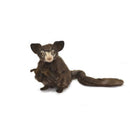Description
5166, AYE AYE 8'' H from Hansa Creations USA, Aye-ayes are nocturnal, so they are most active at night. Due to its specialized body type, behavior, and uniqueness among primates, the aye-aye is included in its own family, genus and species. They have ever-growing incisors and an elongated, flexible middle finger on each of its hands.
1.Aye-ayes sleep in treetop nests they construct. Aye-ayes spend most of their lives high in the trees, especially the canopy. They sleep, travel, and mate in treetops, though they do come down to the ground on occasion. Ayes-ayes are the world's largest nocturnal primate, spending their days curled up in an elaborate ball-like nest of leaves and branches. These nests can take up to 24 hours to construct and are often found in the forks or crowns of tall trees.
2. Aye-ayes are mostly solitary. Adult aye-ayes spend most of their lives alone, only hanging with other aye-ayes during courtship and when the young are dependent on their mother. They mark their territories with urine and scent glands on their cheeks, necks, and rumps. Females have smaller territories that often overlap those of at least a few males. Male aye-ayes tend to tolerate sharing territory with other males, and will even sleep in the same nests (although not at the same time!).
3. They have unusual fingers and toes. Aye-ayes have pointed claws on all their fingers and toes, except for their opposable big toes. This helps them dangle from tree limbs. Their hands are large for their bodies, and their fingers are long and narrow. One finger is a specialized "toilet claw," which the aye-aye uses for grooming.
4. Their feeding method is called "percussive foraging." The aye-aye's third finger is thin and elongated and able to move independently from the other digits. Aye-ayes find grubs and insects within cavities in wood by continuously and rapidly tapping on trees with its middle finger and listening for the sounds of prey beneath. They can tap at a rate of up to eight times per second. Their large ears pick up the sounds of the insects themselves, or perhaps they can distinguish between empty cavities and those full of delicious grubs based on the way their taps reverberate. Once they find a meal, they gnaw a hole in the wood and use those same middle fingers to probe and hook out the goodies. This method of locating and extracting grubs is called percussive foraging.Aye-ayes are omnivores, also eating fruit, nuts, nectar, seeds, and fungi. Those skeletally thin fingers can also be used to scoop out the flesh of coconuts and other fruits, as well as in drinking.
5. They have large, sensitive ears. The huge, bat-like ears of the aye-aye are lined with a complex series of ridges, which help to focus sounds during percussive foraging.
6. They have the teeth of a rodent. Early European naturalists mistakenly classified the aye-aye as a kind of squirrel, partly due to its continually growing incisors. This trait is unique among primates.
7. Aye-Ayes are Madagascar's answer to the woodpecker. The aye-aye, with its ability to detect and rip out grubs from trees, fills the ecological niche of a woodpecker.
8. Aye-ayes communicate with a number of vocalizations. Aye-ayes scream to indicate aggression, and a closed-mouth variation of this scream can indicate protest. When competing over food aye-ayes emit a brief descending whimper. If one sees a human, it might make a "tiss" sound, and when attempting to flee it might make a "hai-hai" vocalization.
9. The aye-aye had a bad reputation. Some people native to Madagascar consider the aye-aye to be an omen of ill luck or a harbinger of evil, and will even kill them on sight. Another superstition about the aye-aye is that if it points its narrow middle finger at someone, they are marked for death. Such hunting, along with habitat destruction, have made the aye-aye critically endangered.
10. There used to be giant aye-ayes. An extinct form of the aye-aye (Daubentonia robusta) once lived in southwest Madagascar. It likely weighed between three and five times what the existing aye-aye species weighs, making it over 25 lbs. It probably co-existed with early humans, but it is not clear if human activity contributed to its extinction or not.
Product Dimension: 7.87(L) X 5.12(W) X 7.87(H)
Each lifelike sculpture and plush creation captures the essence of these remarkable creatures, transporting you to the heart of the savannah. Whether you're a wildlife enthusiast, a collector, or simply seeking to infuse your surroundings with the allure of the safari, HANSA Creation USA's Realistic Safari Animal Collection offers a captivating opportunity to appreciate the beauty and diversity of Africa's iconic wildlife. Choose from our exquisite creations to bring the magic of the African plains into your home or to share the wonder of the safari with those who admire these extraordinary animals.
Artists create each HANSA animal from portraits of the creature in its natural habitat appropriately called Hansa Creation Portrait's in Nature. It is HANSA's uncompromising integrity in design and quality standards that has charmed collectors for generations and continues to mesmerize new collectors of all ages.
Payment & Security
Your payment information is processed securely. We do not store credit card details nor have access to your credit card information.




